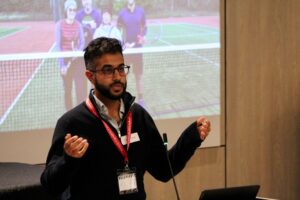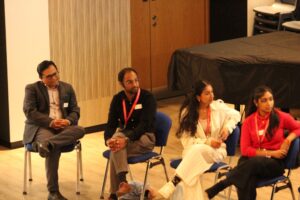
England cricket legend Sir Alastair Cook joined QE Headmaster Neil Enright as well as more than a dozen Old Elizabethans and former members of staff at a special event in the UAE to showcase the new Queen Elizabeth’s School, Dubai Sports City.
The new school, which will open in August 2026, is the first to receive the go-ahead under the QE Global Schools programme – an initiative run by QE Barnet and its international partner, GEDU Global Education.
Former Test and One Day International captain Sir Alastair is GEDU’s Official Education Ambassador. He joined VIP guests from across business, education, sport and media, along with prominent social media figures, for the exclusive networking event held at the site of the new school in Dubai Sports City – a complex built around five major sports venues.
Speaking at the event, Sir Alastair said: “Queen Elizabeth’s School, Barnet, has a remarkable heritage of excellence, ambition and character. To see that legacy now being brought to Dubai is incredibly exciting. This school will give young people the opportunity to thrive, not only academically but personally, developing confidence, ability and responsibility, qualities that are essential for success in any field.”
Sir Alastair will serve as an advisor to the QE Global Schools’ planned élite sports programmes, supporting the development of high-performance pathways and strengthening the role of sport within the wider educational experience.
Mr Enright said: “We are making excellent progress towards the opening of Queen Elizabeth’s School, Dubai Sports City, next August, and I was delighted to meet so many local leaders and people of influence at this reception. It was also great to catch up with alumni and former colleagues now living and working in Dubai.
“There are exciting prospects for international collaboration and for gradually building a global network of Elizabethans, benefitting both the children in the new independent schools and our state-sector pupils in Barnet.
“We also intend to use income from QE Global Schools to support long-term educational excellence at Queen’s Road.”
The CEO of Queen Elizabeth’s Global Schools, Caroline Pendleton-Nash, said: “Our aim was to bring together key members of the media and the wider business community to introduce the exceptional education that will be available from August 2026 at Queen Elizabeth’s School, Dubai Sports City.
“We are gathering real momentum. Admissions have opened to very strong demand for places, and earlier this month we announced Dan Clark as our Founding Principal. These are important steps as we build towards launch.”
Mr Clark has held senior leadership positions at two of the UK’s leading independent schools, Repton and Marlborough College.
“Our hope now is that families across the UAE who aspire to a truly world-class K–12* education will look to Queen Elizabeth’s School as their school of choice,” Mrs Pendleton-Nash added.
She highlighted the significance of Sir Alastair’s involvement: “Having Sir Alastair represent us as an Education Ambassador is a tremendous privilege. His career reflects the exacting values that we seek to instil in every Elizabethan.
“Our location in Dubai Sports City means sport, health and wellbeing will be central to the student experience, supported by élite facilities and expert coaching. To have one of the most respected figures in world sport advising on our élite sports programmes is both inspiring and fitting.
“Sir Alastair Cook exemplifies the confident, able and responsible young people we aim to develop. He is an outstanding role model for our future students.”
* K–12 is short for kindergarten through to 12th grade, reflecting the US school system from the age of around 5 to 17 or 18.
- For more on QE Global Schools, go to our dedicated web pages.
- Click on the thumbnails to view the images.


 Sam is not the only OE at the Premier League. Piers Martin (OE 1987–1995) is Head of Leadership and Workforce Development there. Piers has enjoyed a highly successful career in sport, having previously led several sports’ organisations, including British Fencing at the time of the London 2012 Olympics.
Sam is not the only OE at the Premier League. Piers Martin (OE 1987–1995) is Head of Leadership and Workforce Development there. Piers has enjoyed a highly successful career in sport, having previously led several sports’ organisations, including British Fencing at the time of the London 2012 Olympics.
 Amar Shah (OE 1999-2006) said society is moving so fast that their career preparations are likely to be for job roles that do not yet exist.
Amar Shah (OE 1999-2006) said society is moving so fast that their career preparations are likely to be for job roles that do not yet exist. Amar has moved on to investing in and building other equally exciting businesses.
Amar has moved on to investing in and building other equally exciting businesses.

 The one-day event gave pupils the chance to hear from leading doctors across a range of specialisms – several of whom are involved in medical research – and to talk to current medical students.
The one-day event gave pupils the chance to hear from leading doctors across a range of specialisms – several of whom are involved in medical research – and to talk to current medical students. “This was achieved through a series of insightful talks delivered by some of the most inspiring doctors and medical students we could have asked for, followed by a vibrant networking session in our atrium.”
“This was achieved through a series of insightful talks delivered by some of the most inspiring doctors and medical students we could have asked for, followed by a vibrant networking session in our atrium.” Dr Jayanta Banerjee – Neonatal consultant (St Mary’s Hospital, Imperial College Healthcare NHS Trust)
Dr Jayanta Banerjee – Neonatal consultant (St Mary’s Hospital, Imperial College Healthcare NHS Trust) Soham added: “Organising and hosting this event was a huge learning experience. From coordinating speakers and logistics to dealing with last-moment changes under pressure, it has pushed me to grow as both a team-player and a communicator. It also reaffirmed my passion for Medicine – not just as a career, but as a field built on human connection and constant learning.”
Soham added: “Organising and hosting this event was a huge learning experience. From coordinating speakers and logistics to dealing with last-moment changes under pressure, it has pushed me to grow as both a team-player and a communicator. It also reaffirmed my passion for Medicine – not just as a career, but as a field built on human connection and constant learning.”